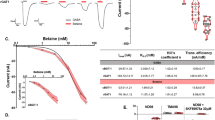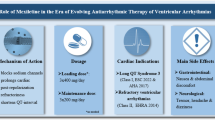Abstract
The existence of mercury in various forms, e.g., elemental, organic, and inorganic has been known for decades. In any of these forms, it is poisonous to metabolism. In this, an investigation about the effect of the inorganic form of mercury, i.e., mercuric chloride (HgCl2) to the mitochondrial voltage-dependent anion channel (VDAC), has been done after isolation from the cardiac and brain tissues of Wistar rats. In vitro electrophysiology experiments were performed in Cardiolipin planar lipid bilayer membrane (BLM) to study the change in the conductance, selectivity, and gating charge of VDAC post HgCl2 treatment. A reduction in mean conductance of VDAC from 4.3 ± 0.18 to 1.66 ± 0.11 nS was observed. Further, the Gating charge calculated before (± 3.5) and after HgCl2 treatment (± 2.3) showed significant difference. Later, VDAC’s behavior was studied at different concentrations of HgCl2 ranging from 0.1 μM to 1 mM. The Inhibitory concentration (IC50) was calculated from the linear regression plot. The IC50 was found to be 488.1 μM. In the asymmetrical HgCl2 (5:1), a permeability ratio of cation to anion was found to be 4.2. It is interpreted that VDAC functioning is affected due to the application of 4 mM HgCl2 and a reduction in the conductance, gating charge, and permeability of VDAC was detected. The results provide clues to HgCl2-induced toxicity mediated through VDAC in the Cardiolipin BLM.
Graphic Abstract






Similar content being viewed by others
Data Availability
Data used in this study will be made available on request.
References
Atchison WD, Hare MF (1994) Mechanisms of methylmercury-induced neurotoxicity. FASEB J 8:622–629
Azarashvili TS, Odinokova IV, Krestinina OV, Baburina YL, Grachev DE, Teplova VV, Holmuhamedov EL (2011) Role of phosphorylation of porin (VDAC) in regulation of mitochondrial outer membrane under normal conditions and alcohol intoxication. Biochem (Moscow) Suppl Ser A 5:11–20. https://doi.org/10.1134/S1990747811010028
Bagger S, Breddam K, Byberg BR (1991) Binding of mercury(II) to protein thiol groups: a study of proteinase K and carboxypeptidase Y. J Inorg Biochem 42:97–103. https://doi.org/10.1016/0162-0134(91)80036-h
Ballatori N, Shi C, Boyer JL (1988) Altered plasma membrane ion permeability in mercury-induced cell injury: studies in hepatocytes of elasmobranch Raja erinacea. Toxicol Appl Pharmacol 95:279–291. https://doi.org/10.1016/0041-008x(88)90164-0
Bayrhuber M et al (2008) Structure of the human voltage-dependent anion channel. Proc Natl Acad Sci 105:15370–15375
Belyaeva EA, Sokolova TV, Emelyanova LV, Zakharova IO (2012) Mitochondrial electron transport chain in heavy metal-induced neurotoxicity: effects of cadmium, mercury, and copper. Sci World J 2012:136063. https://doi.org/10.1100/2012/136063
Benz R, Kottke M, Brdiczka D (1990) The cationically selective state of the mitochondrial outer membrane pore: a study with intact mitochondria and reconstituted mitochondrial porin. Biochem Biophys Acta 1022:311–318
Bera AK, Ghosh S (2001) Dual mode of gating of voltage-dependent anion channel as revealed by phosphorylation. J Struct Biol 135:67–72. https://doi.org/10.1006/jsbi.2001.4399
Bernhoft RA (2012) Mercury toxicity and treatment: a review of the literature. J Environ Public Health 2012:460508. https://doi.org/10.1155/2012/460508
Bridges CC et al (2012) New insights into the metabolism of organomercury compounds: mercury-containing cysteine S-conjugates are substrates of human glutamine transaminase K and potent inactivators of cystathionine γ-lyase. Arch Biochem Biophys 517:20–29. https://doi.org/10.1016/j.abb.2011.11.002
Broussard LA, Hammett-Stabler CA, Winecker RE, Ropero-Miller JD (2002) The toxicology of mercury. Lab Med 33:614–625
Chatterjee S, Banerjee PP, Chattopadhyay A, Bhattacharya S (2013) Low concentration of HgCl2 drives rat hepatocytes to autophagy/apoptosis/necroptosis in a time-dependent manner. Toxicol Environ Chem 95:1192–1207. https://doi.org/10.1080/02772248.2013.862392
Colombini M (1980) Structure and mode of action of a voltage dependent anion-selective channel (VDAC) located in the outer mitochondrial membrane. Ann N Y Acad Sci 341:552–563
Colombini M (1983) Purification of VDAC (voltage-dependent anion-selective channel) from rat liver mitochondria. J Membr Biol 74:115–121
Colombini M (2012) VDAC structure, selectivity, and dynamics. Biochem Biophys Acta 1818:1457–1465. https://doi.org/10.1016/j.bbamem.2011.12.026
De Pinto V et al (2010) Characterization of human VDAC isoforms: a peculiar function for VDAC3? Biochem Biophys Acta 1797:1268–1275. https://doi.org/10.1016/j.bbabio.2010.01.031
Dill ET, Holden MJ, Colombini M (1987) Voltage gating in VDAC is markedly inhibited by micromolar quantities of aluminum. J Membr Biol 99:187–196
Ferreira FF, Nazari EM, Muller YMR (2018) MeHg causes ultrastructural changes in mitochondria and autophagy in the spinal cord cells of chicken embryo. J Toxicol 2018:8460490. https://doi.org/10.1155/2018/8460490
Gincel D, Zaid H, Shoshan-Barmatz V (2001) Calcium binding and translocation by the voltage-dependent anion channel: a possible regulatory mechanism in mitochondrial function. Biochem J 358:147–155
Gochfeld M (2003) Cases of mercury exposure, bioavailability, and absorption. Ecotoxicol Environ Saf 56:174–179. https://doi.org/10.1016/s0147-6513(03)00060-5
Guo TL, Miller MA, Shapiro IM, Shenker BJ (1998) Mercuric chloride induces apoptosis in human T lymphocytes: evidence of mitochondrial dysfunction. Toxicol Appl Pharmacol 153:250–257. https://doi.org/10.1006/taap.1998.8549
Guo XW, Smith PR, Cognon B, D'Arcangelis D, Dolginova E, Mannella CA (1995) Molecular design of the voltage-dependent, anion-selective channel in the mitochondrial outer membrane. J Struct Biol 114:41–59. https://doi.org/10.1006/jsbi.1995.1004
Hadad-Halfon N, Shoshan-Barmatz V (1993) Ca2+ binding sites of the ryanodine receptor/Ca2+ release channel of sarcoplasmic reticulum; characterization by fluorescence measurements. Biochem Soc Trans 21(Pt 3):272S
Harris MH, Vander Heiden MG, Kron SJ, Thompson CB (2000) Role of oxidative phosphorylation in Bax toxicity. Mol Cell Biol 20:3590–3596
Hiller S, Garces RG, Malia TJ, Orekhov VY, Colombini M, Wagner G (2008) Solution structure of the integral human membrane protein VDAC-1 in detergent micelles. Science 321:1206–1210. https://doi.org/10.1126/science.1161302
Hong YS, Kim YM, Lee KE (2012) Methylmercury exposure and health effects. J Prev Med Public Hesalth 45:353–363. https://doi.org/10.3961/jpmph.2012.45.6.353
Israelson A, Abu-Hamad S, Zaid H, Nahon E, Shoshan-Barmatz V (2007) Localization of the voltage-dependent anion channel-1 Ca2+-binding sites. Cell Calcium 41:235–244. https://doi.org/10.1016/j.ceca.2006.06.005
Iverson F, Downie RH, Paul C, Trenholm HL (1973) Methyl mercury: acute toxicity, tissue distribution and decay profiles in the guinea pig. Toxicol Appl Pharmacol 24:545–554. https://doi.org/10.1016/0041-008x(73)90216-0
Krammer EM, Homble F, Prevost M (2011) Concentration dependent ion selectivity in VDAC: a molecular dynamics simulation study. PLoS ONE 6:e27994. https://doi.org/10.1371/journal.pone.0027994
Lemasters JJ, Holmuhamedov E (2006) Voltage-dependent anion channel (VDAC) as mitochondrial governator—thinking outside the box. Biochem Biophys Acta 1762:181–190. https://doi.org/10.1016/j.bbadis.2005.10.006
Levadny V, Colombini M, Li XX, Aguilella VM (2002) Electrostatics explains the shift in VDAC gating with salt activity gradient. Biophys J 82:1773–1783. https://doi.org/10.1016/S0006-3495(02)75528-8
Lin YF, Cheng CW, Shih CS, Hwang JK, Yu CS, Lu CH (2016) MIB: metal ion-binding site prediction and docking server. J Chem Inf Model 56:2287–2291. https://doi.org/10.1021/acs.jcim.6b00407
Liu B, Wang Z, Zhang W, Wang X (2009) Expression and localization of voltage-dependent anion channels (VDAC) in human spermatozoa. Biochem Biophys Res Commun 378:366–370. https://doi.org/10.1016/j.bbrc.2008.10.177
Malik C, Ghosh S (2013) S6 peptide derived from KvAP channel shows cooperativity in gating on bilayer lipid membrane. PLoS ONE 8:e78845. https://doi.org/10.1371/journal.pone.0078845
Malik C, Ghosh S (2020) Quinidine partially blocks mitochondrial voltage-dependent anion channel (VDAC). Eur Biophys J 49:193–205. https://doi.org/10.1007/s00249-020-01426-z
Mannella CA, Colombini M, Frank J (1983) Structural and functional evidence for multiple channel complexes in the outer membrane of Neurospora crassa mitochondria. Proc Natl Acad Sci USA 80:2243–2247. https://doi.org/10.1073/pnas.80.8.2243
Mannella CA, Forte M, Colombini M (1992) Toward the molecular structure of the mitochondrial channel VDAC. J Bioenerg Biomembr 24:7–19
Nahon E, Israelson A, Abu-Hamad S, Varda SB (2005) Fluoxetine (Prozac) interaction with the mitochondrial voltage-dependent anion channel and protection against apoptotic cell death. FEBS Lett 579:5105–5110. https://doi.org/10.1016/j.febslet.2005.08.020
Nesci S, Trombetti F, Pirini M, Ventrella V, Pagliarani A (2016) Mercury and protein thiols: stimulation of mitochondrial F1FO-ATPase and inhibition of respiration. Chem Biol Interact 260:42–49. https://doi.org/10.1016/j.cbi.2016.10.018
Palmeira CM, Madeira VM (1997) Mercuric chloride toxicity in rat liver mitochondria and isolated hepatocytes. Environ Toxicol Pharmacol 3:229–235. https://doi.org/10.1016/s1382-6689(97)00018-5
Parsons D, Bonner W Jr, Verboon J (1965) Electron microscopy of isolated plant mitochondria and plastids using both the thin-section and negative-staining techniques. Can J Bot 43:647–655
Pastorino JG, Hoek JB (2008) Regulation of hexokinase binding to VDAC. J Bioenerg Biomembr 40:171–182. https://doi.org/10.1007/s10863-008-9148-8
Pekel M, Platt B, Busselberg D (1993) Mercury (Hg2+) decreases voltage-gated calcium channel currents in rat DRG and Aplysia neurons. Brain Res 632:121–126
Preston GM, Jung JS, Guggino WB, Agre P (1993) The mercury-sensitive residue at cysteine 189 in the CHIP28 water channel. J Biol Chem 268:17–20
Rice KM, Walker EM Jr, Wu M, Gillette C, Blough ER (2014) Environmental mercury and its toxic effects. J Prev Med Public Health 47:74–83. https://doi.org/10.3961/jpmph.2014.47.2.74
Rostovtseva T, Colombini M (1997) VDAC channels mediate and gate the flow of ATP: implications for the regulation of mitochondrial function. Biophys J 72:1954–1962. https://doi.org/10.1016/S0006-3495(97)78841-6
Rostovtseva TK, Kazemi N, Weinrich M, Bezrukov SM (2006) Voltage gating of VDAC is regulated by nonlamellar lipids of mitochondrial membranes. J Biol Chem 281:37496–37506. https://doi.org/10.1074/jbc.M602548200
Sarikaya S, Karcioglu O, Ay D, Cetin A, Aktas C, Serinken M (2010) Acute mercury poisoning: a case report. BMC Emerg Med 10:7. https://doi.org/10.1186/1471-227X-10-7
Schein SJ, Colombini M, Finkelstein A (1976) Reconstitution in planar lipid bilayers of a voltage-dependent anion-selective channel obtained from paramecium mitochondria. J Membr Biol 30:99–120
Schredelseker J et al (2014) High resolution structure and double electron-electron resonance of the zebrafish voltage-dependent anion channel 2 reveal an oligomeric population. J Biol Chem 289:12566–12577. https://doi.org/10.1074/jbc.M113.497438
Shenker BJ, Guo TL, Shapiro IM (1998) Low-level methylmercury exposure causes human T-cells to undergo apoptosis: evidence of mitochondrial dysfunction. Environ Res 77:149–159. https://doi.org/10.1006/enrs.1997.3816
Tan W, Colombini M (2007) VDAC closure increases calcium ion flux. Biochem Biophys Acta 1768:2510–2515. https://doi.org/10.1016/j.bbamem.2007.06.002
Teijido O, Ujwal R, Hillerdal C-O, Kullman L, Rostovtseva TK, Abramson J (2012) Affixing N-terminal α-helix to the wall of the voltage-dependent anion channel does not prevent its voltage gating. J Biol Chem 287:11437–11445. https://doi.org/10.1074/jbc.M111.314229
Thomas L, Blachly-Dyson E, Colombini M, Forte M (1993) Map** of residues forming the voltage sensor of the voltage-dependent anion-selective channel. Proc Natl Acad Sci USA 90:5446–5449. https://doi.org/10.1073/pnas.90.12.5446
Ujwal R et al (2008) The crystal structure of mouse VDAC1 at 2.3 Å resolution reveals mechanistic insights into metabolite gating. Proc Natl Acad Sci 105:17742–17747
Ulukapi I, Cengiz S, Sandalli N (1994) Effect of mercury from dental amalgams on mercury concentration in urine. J Nihon Univ School Dentist 36:266–268. https://doi.org/10.2334/josnusd1959.36.266
Verma R, Malik C, Azmi S, Srivastava S, Ghosh S, Ghosh JK (2011) A synthetic S6 segment derived from KvAP channel self-assembles, permeabilizes lipid vesicles, and exhibits ion channel activity in bilayer lipid membrane. J Biol Chem 286:24828–24841. https://doi.org/10.1074/jbc.M110.209676
Von Burg R (1995) Inorganic mercury. J Appl Toxicol 15:483–493. https://doi.org/10.1002/jat.2550150610
Yamamoto T et al (2006) VDAC1, having a shorter N-terminus than VDAC2 but showing the same migration in an SDS−polyacrylamide gel, is the predominant form expressed in mitochondria of various tissues. J Proteome Res 5:3336–3344. https://doi.org/10.1021/pr060291w
Ye BJ et al (2016) Evaluation of mercury exposure level, clinical diagnosis and treatment for mercury intoxication. Ann Occup Environ Med 28:5. https://doi.org/10.1186/s40557-015-0086-8
Zhang DW, Colombini M (1989) Inhibition by aluminum hydroxide of the voltage-dependent closure of the mitochondrial channel VDAC. Biochim Biophys Acta 991:68–78
Zizi M, Byrd C, Boxus R, Colombini M (1998) The voltage-gating process of the voltage-dependent anion channel is sensitive to ion flow. Biophys J 75:704–713. https://doi.org/10.1016/S0006-3495(98)77560-5
Acknowledgements
The authors gratefully acknowledge the University of Delhi South Campus for resources.
Funding
Not applicable.
Author information
Authors and Affiliations
Contributions
CM performed the experiments, CM and SG wrote the manuscript and contributed to idea conceptualizations, and SG collected the reagents and chemicals.
Corresponding author
Ethics declarations
Conflict of interest
The authors declare no conflicts of interest.
Ethics Approval
The ethical approval to conduct the experiments have been taken from appropriate authorities and mentioned at the relevant places in the Manuscript.
Additional information
Publisher's Note
Springer Nature remains neutral with regard to jurisdictional claims in published maps and institutional affiliations.
Electronic supplementary material
Below is the link to the electronic supplementary material.
232_2020_134_MOESM1_ESM.pdf
Supplementary file1 (PDF 181 kb) Fig. Appendix-I: The docking of mouse VDAC1 (PDB: 3EMN) with Hg2+. Mercuric ions (green sphere) bind to VDAC Proline at position 5 (a) and Cysteine at position 127 on VDAC.
Rights and permissions
About this article
Cite this article
Malik, C., Ghosh, S. Regulation of Single-Channel Conductance of Voltage-Dependent Anion Channel by Mercuric Chloride in a Planar Lipid Bilayer. J Membrane Biol 253, 357–371 (2020). https://doi.org/10.1007/s00232-020-00134-1
Received:
Accepted:
Published:
Issue Date:
DOI: https://doi.org/10.1007/s00232-020-00134-1




